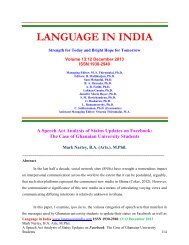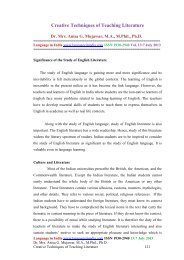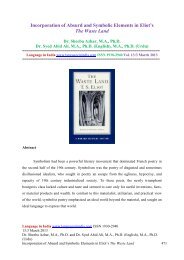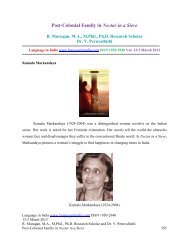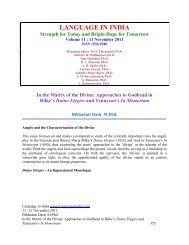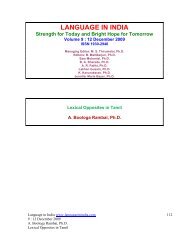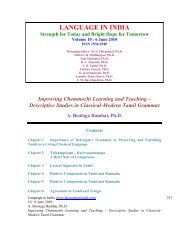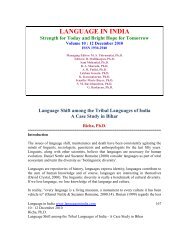- Page 1 and 2: Language in India Strength for Toda
- Page 3 and 4: CHAIRMAN'S CHAIRMAN'S LETTER LETTER
- Page 5 and 6: of Rationalism 14 Progressive Writi
- Page 7 and 8: (iv) (iii) 41 Orissa 41 Maharashtra
- Page 9 and 10: 54 Haryana 54 Delhi Pradesh 55 Karn
- Page 11 and 12: and Kashmir 65 Karnataka 65 Jammu P
- Page 13 and 14: of Safeguards 78 The Memorandum 78
- Page 15 and 16: 101 The Great Rebellion 102 Backgro
- Page 17 and 18: (Vii) Interest 125 Fort William Col
- Page 19 and 20: Bibliography 136 Grants for Librari
- Page 21 and 22: of Urdu at the various levels and a
- Page 23 and 24: The Committee for Promotion of Urdu
- Page 25 and 26: Prior to its issue, the Resolution
- Page 27 and 28: which official and non-official eff
- Page 29 and 30: Prof. M. Mujeeb 3. Prof. Abdul Alee
- Page 31 and 32: New Delhi August 7, 8 and 9, 1973 1
- Page 33 and 34: and Public Instruction; Directors o
- Page 35 and 36: The collection and collation of fac
- Page 37 and 38: HISTORICAL HISTORICAL BACKGROUND BA
- Page 39 and 40: Early Early History History them al
- Page 41 and 42: Braj Bhasha was the leading languag
- Page 43 and 44: In Namdeva's creations,one can spot
- Page 45: the Ate and the common man, its fou
- Page 49 and 50: Abdul Rahim Khan-i-Khanan, Surdas,
- Page 51 and 52: of marsia (elegy) writing was also
- Page 53 and 54: a. literary elegance, while his gha
- Page 55 and 56: fondly embraced. "Ama- nat's" opera
- Page 57 and 58: like Bagh-o-Bahar, Hatim-Tai, Singh
- Page 59 and 60: Contacts Contacts with with West We
- Page 61 and 62: Age Age of of Rationalism Rationali
- Page 63 and 64: Not all the poets or writers belong
- Page 65 and 66: Sikhism have been published in Urdu
- Page 67 and 68: A very significant event of the twe
- Page 69 and 70: New New Writing Writing Gopi Chand
- Page 71 and 72: The modern period is also remarkabl
- Page 73 and 74: Total number of speakers Kannada 21
- Page 75 and 76: It will be noticed that while the n
- Page 77 and 78: Karnataka 6,51,696 20,34,482 26,36,
- Page 79 and 80: 21 V Name of State/ Urdu spoken as
- Page 81 and 82: Urban Urban and and RRural R Rural
- Page 83 and 84: Concentrations Concentrations Conce
- Page 85 and 86: Darbhanga 11.61 3 Purnea 31.29 2 An
- Page 87 and 88: The language problem had been exerc
- Page 89 and 90: "No citizen shall, on grounds only
- Page 91 and 92: Language Language and and Constitut
- Page 93 and 94: Hindustani Hindustani The reference
- Page 95 and 96: This aspecl of the, problem has not
- Page 97 and 98:
This was a modification of the reco
- Page 99 and 100:
and the decisions of the Zonal Coun
- Page 101 and 102:
The status of Urdu, as can be seen,
- Page 103 and 104:
a Directive under Article 347, he t
- Page 105 and 106:
The State Government of Aadhra Prad
- Page 107 and 108:
EDUCATION. EDUCATION. Background Ba
- Page 109 and 110:
The Delhi College, founded in 1825,
- Page 111 and 112:
Tile Education Despatch of 1854, is
- Page 113 and 114:
The cumulative effect of all these
- Page 115 and 116:
The University of Calcutta also all
- Page 117 and 118:
was published in 1944. Sargent exam
- Page 119 and 120:
The Provincial Education Ministers'
- Page 121 and 122:
with particular reference to pupils
- Page 123 and 124:
The 10 : 40 formula evolved by the
- Page 125 and 126:
many hurdles and delays. As the dev
- Page 127 and 128:
Minister of Andhra Pradesh indicate
- Page 129 and 130:
In the course of our discussions wi
- Page 131 and 132:
It was suggested to us that Urdu sc
- Page 133 and 134:
Himachal Pradesh : Hindi is the med
- Page 135 and 136:
Madhya Pradesh There is a sizable n
- Page 137 and 138:
The witnesses expressed general sat
- Page 139 and 140:
schools had been terminated. In 196
- Page 141 and 142:
Urdu speakers constituted 10.5 per
- Page 143 and 144:
of Bara Banki. It was, therefore, a
- Page 145 and 146:
case may be. Here again, many schoo
- Page 147 and 148:
exists in its original form. It had
- Page 149 and 150:
provision to cover the right of ins
- Page 151 and 152:
accordingly, took up the question o
- Page 153 and 154:
The 15 : 60 formula for the seconda
- Page 155 and 156:
The Three Language Formula. was re-
- Page 157 and 158:
was : middle 903, secondary 173, an
- Page 159 and 160:
special notice as it has been an ac
- Page 161 and 162:
of Urdu speakers about continued ne
- Page 163 and 164:
schools and arrangements for teachi
- Page 165 and 166:
Some witness suggested the formatio
- Page 167 and 168:
did not work. We have dealt with it
- Page 169 and 170:
States like Karnataka, Maharashtra,
- Page 171 and 172:
the right given in the matter of th
- Page 173 and 174:
to linguistic minorities, but -not
- Page 175 and 176:
Maharashtra : The Commissioner for
- Page 177 and 178:
other than Sanskrit, the case may b
- Page 179 and 180:
English or any other modern Europea
- Page 181 and 182:
linguistic minorities by substituti
- Page 183 and 184:
asic principles for training were t
- Page 185 and 186:
institutions. The Director of Educa
- Page 187 and 188:
Urdu and Telugu decreased gradually
- Page 189 and 190:
training were required to teach thr
- Page 191 and 192:
and this can be done in the case of
- Page 193 and 194:
slightly compared to 1963, there ha
- Page 195 and 196:
in Himachal Pradesh from the academ
- Page 197 and 198:
languages. It has developed criteri
- Page 199 and 200:
Orissa, Punjab, Rajasthan and West
- Page 201 and 202:
translations of textbooks in social
- Page 203 and 204:
If the State finds it difficult to
- Page 205 and 206:
languages would be published by the
- Page 207 and 208:
The distribution machinery for Urdu
- Page 209 and 210:
knowing Inspectors. Under the circu
- Page 211 and 212:
y the libraries and pleaded for spe
- Page 213 and 214:
secondary colleges in an area. Notw
- Page 215 and 216:
mentioned for the opening of M. A.
- Page 217 and 218:
institute in the South should be lo
- Page 219 and 220:
of the view that owing to various f
- Page 221 and 222:
ADMINISTRATION ADMINISTRATION Vide
- Page 223 and 224:
The fortunes of Sanskrit may have d
- Page 225 and 226:
usiness In the ad- ministrative dep
- Page 227 and 228:
different provinces of India. In th
- Page 229 and 230:
any such court and in what characte
- Page 231 and 232:
There was yet another disquieting f
- Page 233 and 234:
composition of population in most S
- Page 235 and 236:
groups to secure their support for
- Page 237 and 238:
Commissioner Commissioner for for f
- Page 239 and 240:
The Ministerial Committee of the So
- Page 241 and 242:
We are gratified that the Union Gov
- Page 243 and 244:
to the Commissioner for Linguistic
- Page 245 and 246:
The State Government should make ad
- Page 247 and 248:
was not equipped to undertake trans
- Page 249 and 250:
Jammu and Kashmir : Representations
- Page 251 and 252:
not be difficult for the State Gove
- Page 253 and 254:
A well accepted concept of administ
- Page 255 and 256:
elief by giving recognition to mino
- Page 257 and 258:
A number of witnesses also demanded
- Page 259 and 260:
30 marks out of a hundred. The mark
- Page 261 and 262:
In the State services, the medium o
- Page 263 and 264:
the examination papers for the Stat
- Page 265 and 266:
the Administration to hold a profic
- Page 267 and 268:
according to the report of Linguist
- Page 269 and 270:
and bye-laws issued under the Const
- Page 271 and 272:
to the official languages. The poli
- Page 273 and 274:
Electoral Electoral Rolls Rolls Thi
- Page 275 and 276:
and implementing authorities are eq
- Page 277 and 278:
the translation for notices, etc.,
- Page 279 and 280:
Andhra Pradesh, Uttar Pradesh, Biha
- Page 281 and 282:
It was generally conceded by the wi
- Page 283 and 284:
Leh broadcasts Urdu programmes for
- Page 285 and 286:
western and central Urrar Pradesh,
- Page 287 and 288:
news bulletins were often translate
- Page 289 and 290:
farmer entrepreneur small-sclae ind
- Page 291 and 292:
Maharashtra, Punjab and Uttar Prade
- Page 293 and 294:
"a further review at the all-India
- Page 295 and 296:
JOURNALISM 101 JOURNALISM Backgroun
- Page 297 and 298:
included two magazines. The aggrega
- Page 299 and 300:
The The Great Great Rebellion Rebel
- Page 301 and 302:
the Punjab Akhbar, Lahore; the Sham
- Page 303 and 304:
The Urdu newspapers and periodicals
- Page 305 and 306:
the concern at the growing unemploy
- Page 307 and 308:
fast, they felt that their leadersh
- Page 309 and 310:
Urdu Urdu Press Press Over Overseas
- Page 311 and 312:
in the thirties wag the weekly Azad
- Page 313 and 314:
of a democratic system are reflecte
- Page 315 and 316:
73 7 80 308 320 708 12.40 1966 83**
- Page 317 and 318:
Most of the drawbacks from which Ur
- Page 319 and 320:
carried out." Government of India i
- Page 321 and 322:
110 of Paper 1966 1967 1968 1969 19
- Page 323 and 324:
The circulation increase in the cas
- Page 325 and 326:
Most of the difficulties of the Urd
- Page 327 and 328:
lakh for receiving machinery on hir
- Page 329 and 330:
Newsprint Newsprint Industries Orga
- Page 331 and 332:
of newsprint, namely, 77,192.01 met
- Page 333 and 334:
A demand has also been voiced that
- Page 335 and 336:
important because to be on the Gove
- Page 337 and 338:
small, functions as opinion maker a
- Page 339 and 340:
The same applies to sales promotion
- Page 341 and 342:
and Visual Publicity or the corresp
- Page 343 and 344:
the percentage has been fluctuating
- Page 345 and 346:
section or region remains uncovered
- Page 347 and 348:
submit the proposal to D.A.V.P. for
- Page 349 and 350:
and regularity of publication,prefe
- Page 351 and 352:
of Urdu newspapers still leaves muc
- Page 353 and 354:
and money, not to mention the avoid
- Page 355 and 356:
Kitabat Kitabat and and Composition
- Page 357 and 358:
A number of witnesses and later som
- Page 359 and 360:
The basic problem that Urdu faces t
- Page 361 and 362:
cottage industry workers dwell. Thi
- Page 363 and 364:
at Ghazipur. On his suggestion, the
- Page 365 and 366:
of presses rose to 23, which publis
- Page 367 and 368:
there. Financed by donations and su
- Page 369 and 370:
Anthologies of Urdu 6 Literature 5
- Page 371 and 372:
experiment was made by a few journa
- Page 373 and 374:
and Pakistan. The facilities of typ
- Page 375 and 376:
that Hindi could take the initiativ
- Page 377 and 378:
give liberal subsidies to writers/p
- Page 379 and 380:
Adopt Hindi technical terms in olde
- Page 381 and 382:
languages. It will make for conveni
- Page 383 and 384:
notes about such Urdu writers as ha
- Page 385 and 386:
quality. At least the Sahitya Akade
- Page 387 and 388:
Publisher's Publisher's Problems Pr
- Page 389 and 390:
to sell, even after making allowanc
- Page 391 and 392:
Calligraphers' Ink : The calligraph
- Page 393 and 394:
e given to literary bodies, Urdu ac
- Page 395 and 396:
These workshops could also conduct
- Page 397 and 398:
libraries maintained by the Governm
- Page 399 and 400:
languages with which it came into c
- Page 401 and 402:
(1887); and the Hurriyat, Tashkent
- Page 403 and 404:
therefore, Urdu has to depend heavi
- Page 405 and 406:
climate of goodwill towards the lan
- Page 407 and 408:
form the pattern with such amplific
- Page 409 and 410:
Given a fair trial, these recommend
- Page 411 and 412:
Delhi : It was stated that the Delh
- Page 413 and 414:
and Urdu knowing teachers appointed
- Page 415 and 416:
the above formula., may not be appl
- Page 417 and 418:
The Committee noticed that the Nati
- Page 419 and 420:
There may not he a case for opening
- Page 421 and 422:
Inspecting Inspecting Staff Staff W
- Page 423 and 424:
Urdu Urdu Research Research Institu
- Page 425 and 426:
Translation Translation of of Laws
- Page 427 and 428:
in Urdu should not be restricted in
- Page 429 and 430:
gap has developed. The gap should b
- Page 431 and 432:
whole position in consultation with
- Page 433 and 434:
translated laws will be available t
- Page 435 and 436:
Posts Posts and and Telegraphs Tele
- Page 437 and 438:
Sign Sign Sign Boards Boards Boards
- Page 439 and 440:
giving sufficient attention to Musl
- Page 441 and 442:
It would be worthwhile trying to pu
- Page 443 and 444:
with a sizable population of Urdu s
- Page 445 and 446:
Similar arrangements should exist i
- Page 447 and 448:
Advertisements to delivery of the n
- Page 449 and 450:
The disproportionate rise in postal
- Page 451 and 452:
Urdu Urdu Academies Academies The C
- Page 453 and 454:
The composition of the Committee ap
- Page 455 and 456:
Scholars Scholars Empritus Empritus
- Page 457 and 458:
ooks in Devnagri script, in additio
- Page 459 and 460:
Calligraphy Calligraphy There is ob
- Page 461 and 462:
wherever demand for Urdu books exis
- Page 463 and 464:
Sales Sales Organisation Organisati
- Page 465 and 466:
I. I. RESOLUTION RESOLUTION OF OF T
- Page 467 and 468:
whether the finances of the provinc
- Page 469 and 470:
14-The State shall not deny to any
- Page 471 and 472:
Notwithstanding anything in clause
- Page 473 and 474:
that if two or more States agree th
- Page 475 and 476:
351.-It shall be the duty of the Un
- Page 477 and 478:
which are proposed to be taught at
- Page 479 and 480:
The Commission has further suggeste
- Page 481 and 482:
y the Pre- sident, has not been wel
- Page 483 and 484:
languages, and the various provisio
- Page 485 and 486:
egret that the question of language
- Page 487 and 488:
scale is made, the State Government
- Page 489 and 490:
(iii) action by Government to see t
- Page 491 and 492:
linguistic majority group in each S
- Page 493 and 494:
Facilities for registration of docu
- Page 495 and 496:
Definition of persons eligible for
- Page 497 and 498:
the second class language test in T
- Page 499 and 500:
according to the States Reorganisat
- Page 501:
and should any problem arise, it wo



